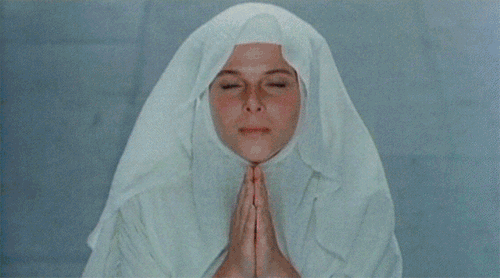← Back to Reviews
in

The Lair of the White Worm
(Ken Russell, 1988)
Prior to watching The Lair of the White Worm (which, coincidentally, happens to be the online alias of my underwear), I'd only seen three of Ken Russell's films: Tommy, Altered States and Whore. My reception to those films was lukewarm, but after watching and loving this bizarre, kinky, occasionally phantasmagoric slice of horror/comedy/camp, I now feel a strong urge to immediately seek out Russell's entire filmography. His reputation for making flamboyant, controversial, psychosexual films lives up to its billing with this particular work.
If you're the anal type prone to getting technicalities tangled in your hemorrhoids, The Lair of the White Worm isn't about vampires . . . but it's totally about vampires. Based on a Bram Stoker novel of the same name (wait, he wrote something besides Dracula?), the tale revolves around a mythical snake-like creature, the d'Ampton worm, and the immortal priestess who worships the monster like a god and throws the occasional human sacrifice down its deep, cavernous wormhole. The priestess's fangs are more snake-like than bat-like, but as with traditional vampirism, a bite means infection. Persuasion is a superpower. Christian iconography equals revulsion. (There's a great scene of the priestess hissing and spraying venom on a crucifix.) Unlike traditional vampires, however, daylight is no refuge, and instead of a wooden stake, bring with you a big-ass sword and some bagpipes.

Seeing Hugh Grant's name in the opening credits is typically a sign of approaching suckitude, but he delivers a commendable performance as a descendent of the man believed to have slayed the d'Ampton worm centuries ago. Grant's trademark British pompousness still hovers around him like bad body odor, but since he's playing the Lord of the Manor, the pompousness suits his character. Peter Capaldi plays a Scottish archeologist who unearths a large, dragon-like skull on the grounds of an old convent, setting in motion the dastardly events to come. (The young Capaldi could pass for Grant's doppelganger if Grant put zero effort into his appearance.) Sammi Davis and Catherine Oxenburg play sisters whose parents have gone missing. They're at their best early in the film when they're all bubbly and giggly with their cute accents rather than later in the film when they become typical damsels in distress.
The true star of this perverse, cinematic pleasure is Amanda Donohoe as the aforementioned snake priestess, Lady Sylvia Marsh. Whether she's tempting an underage boy in the bathtub or discussing the therapeutic benefits of Snakes & Ladders, her mere presence turns every scene into a highlight. She's sexy, seductive, frequently in a state of undress, and equipped with a stare as dangerously trance-like as Medusa's. Unlike Bram Stoker's most famous creation, Lady Sylvia Marsh sleeps not in a coffin, but in a large wicker basket befitting a cobra. In one memorable scene, snake-charming music is blasted into the night, causing Lady Sylvia Marsh to slither out of her basket, hypnotized by the soundwaves, her body gesticulating like a serpent. The image is intentionally amusing, but like the rest of the film's odd tone, the humor is deceptively tongue-in-cheek. It's clear from the wink-wink-nudge-nudge dialogue and the flamboyant camp of several scenes that Russell and company knew of the darkly comedic undertones pulsing through the story. Yet the relative poker face with which the material is delivered might deceive some viewers into thinking that the film is taking itself seriously. As long as you're attuned to the same wavelength as Ken Russell, however, you're in for a hellishly fun ride.

The Lair of the White Worm features a ton of phallic imagery. The camera zooms in on Grant's pen rising steadily like an erection as he watches dream versions of his girlfriend and Lady Sylvia Marsh cat-fighting in stewardess outfits. (Just one of many WTF sequences.) You'll also think you've clicked on the "BBC" category of your go-to fap site when watching Lady Sylvia Marsh bust hymens with a wicked black staff which she provocatively licks. There's some beautiful blasphemy on display during the hallucinogenic dream sequences: topless nuns getting gang-raped; a white snake coiled around Jesus on the cross; flames and fangs and blood, blood, blood. Sometimes Lady Sylvia Marsh is painted blue, sometimes green. I'm unsure if that's a result of chameleon abilities or her very own spray-tan salon. Russell has a knack of withholding information from viewers to accentuate surprise and suspense, especially when it comes to who's been bitten or not. The set-design and the special-effects are wonderfully kitsch. The script is mostly absent of unnecessary exposition. (Delivering the legend of the d'Ampton worm through a jovial, boot-stomping musical number at an annual banquet is rather clever.) The director of photography is named Dick Bush. (I don't have anything to say about the photography. I just wanted to type Dick Bush.)
The Lair of the White Worm isn't a film for everyone, but if you're into any kind of banging, or if the sight of a cross results in violent, paganistic flashbacks, or even if you just feel an urge to toss your Snakes & Ladders board game into the fireplace, it might be time to stop for a bite and throw on this wonderfully perverted, highly memorable, darkly humorous slice of vampiric camp.



The Lair of the White Worm
(Ken Russell, 1988)
Prior to watching The Lair of the White Worm (which, coincidentally, happens to be the online alias of my underwear), I'd only seen three of Ken Russell's films: Tommy, Altered States and Whore. My reception to those films was lukewarm, but after watching and loving this bizarre, kinky, occasionally phantasmagoric slice of horror/comedy/camp, I now feel a strong urge to immediately seek out Russell's entire filmography. His reputation for making flamboyant, controversial, psychosexual films lives up to its billing with this particular work.
If you're the anal type prone to getting technicalities tangled in your hemorrhoids, The Lair of the White Worm isn't about vampires . . . but it's totally about vampires. Based on a Bram Stoker novel of the same name (wait, he wrote something besides Dracula?), the tale revolves around a mythical snake-like creature, the d'Ampton worm, and the immortal priestess who worships the monster like a god and throws the occasional human sacrifice down its deep, cavernous wormhole. The priestess's fangs are more snake-like than bat-like, but as with traditional vampirism, a bite means infection. Persuasion is a superpower. Christian iconography equals revulsion. (There's a great scene of the priestess hissing and spraying venom on a crucifix.) Unlike traditional vampires, however, daylight is no refuge, and instead of a wooden stake, bring with you a big-ass sword and some bagpipes.

Seeing Hugh Grant's name in the opening credits is typically a sign of approaching suckitude, but he delivers a commendable performance as a descendent of the man believed to have slayed the d'Ampton worm centuries ago. Grant's trademark British pompousness still hovers around him like bad body odor, but since he's playing the Lord of the Manor, the pompousness suits his character. Peter Capaldi plays a Scottish archeologist who unearths a large, dragon-like skull on the grounds of an old convent, setting in motion the dastardly events to come. (The young Capaldi could pass for Grant's doppelganger if Grant put zero effort into his appearance.) Sammi Davis and Catherine Oxenburg play sisters whose parents have gone missing. They're at their best early in the film when they're all bubbly and giggly with their cute accents rather than later in the film when they become typical damsels in distress.
The true star of this perverse, cinematic pleasure is Amanda Donohoe as the aforementioned snake priestess, Lady Sylvia Marsh. Whether she's tempting an underage boy in the bathtub or discussing the therapeutic benefits of Snakes & Ladders, her mere presence turns every scene into a highlight. She's sexy, seductive, frequently in a state of undress, and equipped with a stare as dangerously trance-like as Medusa's. Unlike Bram Stoker's most famous creation, Lady Sylvia Marsh sleeps not in a coffin, but in a large wicker basket befitting a cobra. In one memorable scene, snake-charming music is blasted into the night, causing Lady Sylvia Marsh to slither out of her basket, hypnotized by the soundwaves, her body gesticulating like a serpent. The image is intentionally amusing, but like the rest of the film's odd tone, the humor is deceptively tongue-in-cheek. It's clear from the wink-wink-nudge-nudge dialogue and the flamboyant camp of several scenes that Russell and company knew of the darkly comedic undertones pulsing through the story. Yet the relative poker face with which the material is delivered might deceive some viewers into thinking that the film is taking itself seriously. As long as you're attuned to the same wavelength as Ken Russell, however, you're in for a hellishly fun ride.

The Lair of the White Worm features a ton of phallic imagery. The camera zooms in on Grant's pen rising steadily like an erection as he watches dream versions of his girlfriend and Lady Sylvia Marsh cat-fighting in stewardess outfits. (Just one of many WTF sequences.) You'll also think you've clicked on the "BBC" category of your go-to fap site when watching Lady Sylvia Marsh bust hymens with a wicked black staff which she provocatively licks. There's some beautiful blasphemy on display during the hallucinogenic dream sequences: topless nuns getting gang-raped; a white snake coiled around Jesus on the cross; flames and fangs and blood, blood, blood. Sometimes Lady Sylvia Marsh is painted blue, sometimes green. I'm unsure if that's a result of chameleon abilities or her very own spray-tan salon. Russell has a knack of withholding information from viewers to accentuate surprise and suspense, especially when it comes to who's been bitten or not. The set-design and the special-effects are wonderfully kitsch. The script is mostly absent of unnecessary exposition. (Delivering the legend of the d'Ampton worm through a jovial, boot-stomping musical number at an annual banquet is rather clever.) The director of photography is named Dick Bush. (I don't have anything to say about the photography. I just wanted to type Dick Bush.)
The Lair of the White Worm isn't a film for everyone, but if you're into any kind of banging, or if the sight of a cross results in violent, paganistic flashbacks, or even if you just feel an urge to toss your Snakes & Ladders board game into the fireplace, it might be time to stop for a bite and throw on this wonderfully perverted, highly memorable, darkly humorous slice of vampiric camp.


